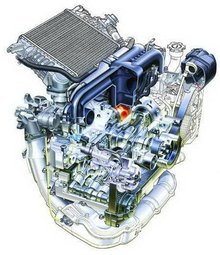Automotive radiators are an indispensable part of the automotive water-cooled engine cooling system and are moving towards light, efficient and economical. The structure of the car radiator is also constantly adapting to new developments.
The most common structural forms of automotive radiators can be divided into DC type and cross flow type.
The structure of the radiator core mainly includes two types of tube type and tube belt type. The tube-type radiator core is composed of a plurality of thin cooling tubes and fins, and the cooling tubes mostly adopt a flat circular cross section to reduce air resistance and increase heat transfer area.
 散热系统
散热系统
The radiator core should have sufficient flow area to allow coolant to pass through, and should also have sufficient air flow area to allow sufficient air to pass through to remove the heat transferred to the radiator by the coolant. [1]
At the same time, it must have sufficient heat dissipation area to complete the heat exchange between the coolant, air and heat sink.
The tube-and-belt heat sink is formed by welding a corrugated heat-dissipating belt and a cooling tube.
Compared with the tube-type heat sink, the tube-type heat sink can increase the heat-dissipation area under the same conditions.
As far as the heat sink material is concerned, the thermal conductivit...
Tips for simple cleaning of car radiators. First remov...
The radiator is specially designed for the heat dissipation of the car...
In summer, the frequency of use of vehicle air conditioners has increa...
If the water tank of the vehicle is improperly handled during normal d...
First, the engine lubricant quantity check Park the vehicle on a level...
There are two main types of car radiators: aluminum and copper. The fo...
Automotive radiators are an indispensable part of the automotive water...